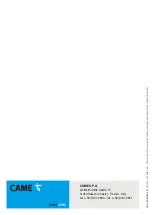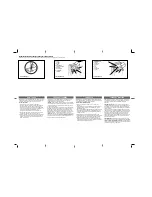
MASTER
SLAVE
MASTER
SLAVE
M
anu
al
FA
011
61
-E
N
- 0
8/
20
18 - © C
AM
E S
.p
.A
. - T
he c
on
te
nt
s o
f t
hi
s m
anu
al m
ay c
ha
ng
e, a
t a
ny t
im
e, a
nd wi
th
ou
t n
ot
ic
e.
-
Or
igin
al
in
st
ru
ct
io
ns
PAIRED CONNECTION AND OPERATION
Electrical wiring
Fit the RSE card (with the DIP-switches set to OFF) to the connector on the control panels of both operators.
Connect the two panels by using a CAT 5 (max 1,000 m type cable to terminals A-A / B-B / GND-GND, see paragraph called PAIRED
OPERATION.
Connect all of the control and safety devices on the MASTER operator's control panel.
Programming
Continue making the settings and adjustments only on the MASTER panel.
Start programming by first running the following functions:
- managing serial connection (F49);
- opening direction (F54);
- parameter exchange in paired mode (F52).
Saving
Execute the procedure, to add a user with an associated command, on the MASTER panel.
Operating modes
Either STEP-STEP or ONLY OPEN command. Both leaves open.
PARTIAL/PEDESTRIAN OPENING command. Only the MASTER operator's leaf opens.
For the types of command that can be selected and paired to users, see the ENTERING USERS WITH ASSOCIATED COMMANDS.
DISMANTLING AND DISPOSAL
☞
CAME S.p.A. applies a certified Environmental Management System at its premises, which is compliant with the UNI EN ISO
14001 standard to ensure the environment is safeguarded.
Please continue safeguarding the environment. At CAME we consider it one of the fundamentals of our operating and market
strategies. Simply follow these brief disposal guidelines:
DISPOSING OF THE PACKAGING
The packaging materials (cardboard, plastic, and so on) should be disposed of as solid household waste, and simply separated from
other waste for recycling.
Always make sure you comply with local laws before dismantling and disposing of the product.
DISPOSE OF RESPONSIBLY!
DISMANTLING AND DISPOSAL
Our products are made of various materials. Most of these (aluminum, plastic, iron, electrical cables) are classified as solid household
waste. They can be recycled by separating them before dumping at authorized city plants.
Whereas other components (control boards, batteries, transmitters, and so on) may contain hazardous pollutants.
These must therefore be disposed of by authorized, certified professional services.
Before disposing, it is always advisable to check with the specific laws that apply in your area.
DISPOSE OF RESPONSIBLY!


































